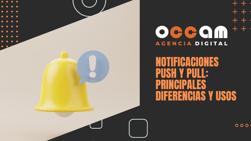Index Content
what steps should you take to structure articles and what are the advantages of this planning? In this article we explain it to you
In a content marketing strategy, the goal is to create interesting material for your potential customers. Internet users should feel the need to read your blog articles, but the key is to get them to share them with their personal circle. Remember that the greatest proof that a content is enriching and useful for users is that they take the trouble to share it with their acquaintances. And what can you do to reach that level of satisfaction with your readers? One of the answers you will find in this article is to structure articles always thinking about your target audience.
Advantages of structuring articles
what is the point of structuring articles and why should you invest time in planning their development? OCCAM explains these five advantages:
- it helps to decide the title: If you know what you are going to talk about in detail, the title you establish before writing will have a better chance of remaining relevant once you have finished.
- it makes the writing process easier: The outline is a response to a previous research task, so it will be much easier to write with a clear idea of the sections of the article and the sources of information. Otherwise, you could come up blank in the middle or break the unity of the entry.
- it saves time: structuring articles is an investment, not a waste of time; in fact, by making the writing process smoother, it optimises your efforts and prevents you from facing a blank piece of paper.
- it demonstrates the viability of an idea. You may be writing about a topic that you lack information on and that is not really useful to readers, but if you develop an outline, you will realise this before you start writing and will not have to scrap your work.
- it allows readers to better understand and remember the content. A clear structure directs users' reading and helps them navigate through the article.
Steps for structuring articles
From the first word of the title to the final point of the conclusion, you need to pay attention to every detail of your blog posts, so find out how to structure eye-catching articles for your buyer personas by climbing these five steps:
-
choose the topic
Following the necessary planning of your content strategy, you have to generate article ideas to fuel your campaign. Keep in mind that your blog should be more focused on creating educational and didactic material than on writing about your brand and its services. Therefore, focus your efforts on pointing out the problems of your potential customers and the questions they ask on the Internet to solve them with your content.
In this sense, it is essential to make a study of the keywords in your sector and the specific topics you want to write about. Thus, you will create general content on the essential concepts, as well as more specific content based on long-tail keywords. For example, a general one would be: "What is inbound marketing". On the other hand, a specific one could be: "The stages of the buyer's journey" (in bold I highlight the keywords of each title).
Combine these two types of titles and remember that all the content must be related to the topics on which you want to position yourself as a reference in your sector.
-
create the title
The title is the showcase of your article and it depends on it whether users want to click on it, read it or ignore it. Therefore, it must be attractive, but also direct, concise and clear. It must faithfully summarise all your content, as no one wants to feel cheated: of course, avoid clikbait.
First, you will write a provisional title that you will review when you finish writing the article to check that it is faithful to its content. At that time, bear in mind these recommendations: try to keep the title to no more than 60 characters, always include the keyword (better if you place it at the beginning) and use square brackets if you consider it appropriate. Think about how your potential customers search on the Internet and try to adapt the titles to this.
-
establish the structure
You will need to structure articles according to topic and title, but the most common, simple and ideal methods are these two:
- list: Include an introduction, a list of the essential points of the article that respond to the title and a conclusion. An example would be: "15 tips to improve as a community manager". Here, each tip is a point in the list. These articles are visually appealing and easy for the user to navigate through.
- instructions: Include an introduction, a paragraph of context (for example, explaining the advantages of implementing mailing in a company) and a list of instructions or steps to follow. An example would be the article you are reading right now.
Although these are the most recommended formats, you can use the structure you consider most appropriate in each case, but remember that the aim is to win the reader over so that their experience with the content (and the company in general) is as enriching as possible.
-
develop the body of the article
According to HubSpot, the recommended length for blog posts is 2,100 words, and the vast majority belong to the development. Therefore, let's look at some recommendations for writing the body of the articles:
- don't overuse the keyword, try to include it organically throughout the content, otherwise the user will see your article as opportunistic and may feel cheated.
- use subheadings- this is essential, both for SEO and for structuring articles, so use the hierarchy of headings and set a unique size and layout for each one, so readers can easily identify where they are in the article.
- use bold to highlight what is most important. The use of bold is useful to add dynamism to the article, but it can also harm the reading if it is not used correctly. Therefore, avoid highlighting too many words or phrases because it is an exceptional resource to highlight what is most important. If you highlight most of the text, then you will not be highlighting anything.
- incorporate visual elements such as images or videos. To enrich the content and make it more eye-catching, include visual resources. These can be stock photos, YouTube videos, social links, infographics, etc. In these cases, try to include your own content that belongs to your marketing strategy.
Finally, don't forget the web design (give the white space the prominence it deserves) and the responsive design, which will guarantee a correct reading from any device. Remember to always follow the editorial plan of the strategy to maintain the unity and concordance between all the content of the website.
-
Write the introduction and conclusion
The ideal when writing an article is to leave both the introduction and the conclusion for the end. This is because, once you have the body and the general development of the content ready, you will be able to introduce and close it more successfully.
The introduction, being at the beginning, should be attractive to arouse the reader's interest. You can anticipate the content of the article, use humour, rhetorical questions, a curiosity, a quote... Try to be original.
For its part, the conclusion should be useful, as its task is to summarise the content and remind users of what is most important. In this sense, you can allude to the title or the introduction to recover a witty phrase or an essential concept that you want to remain in the reader's memory. Going back to the beginning to close the article makes it more complete and seems like a closed circle.
Now that you know the benefits of structuring articles and the steps involved, get started!





